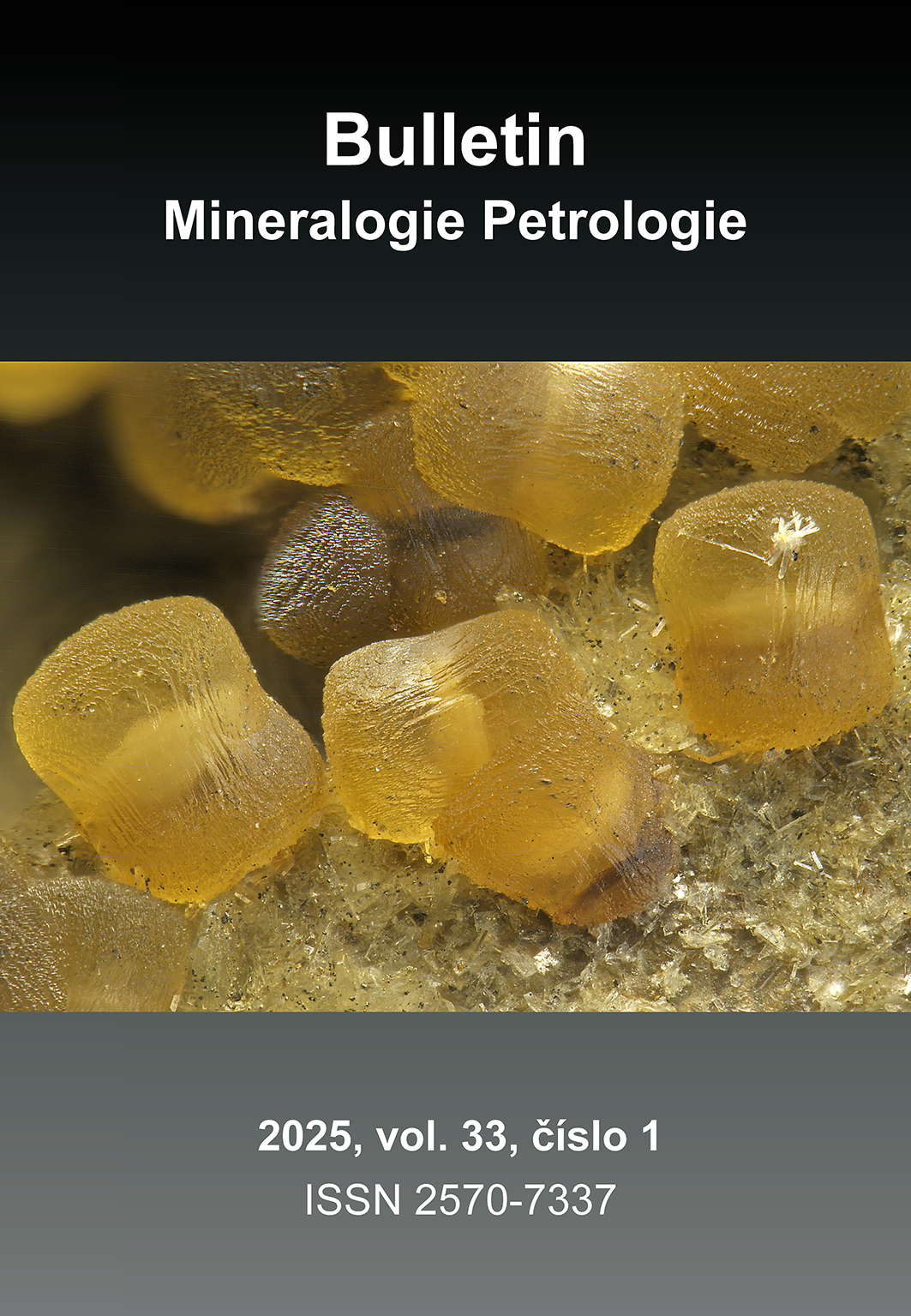Minerály „ottrélitových“ břidlic u Vápenného Podola v Železných horách (Česká republika)
Minerals of the „ottrélite“ schists from Vápenný Podol in the Železné Hory Mts. (Czech Republic)
Klíčová slova
Abstrakt
From the belt of Ordovician metapelites in the Železné hory Mountains, ottrélite was described in 1882. Although the original paper stated the virtual absence of manganese, many papers and books from the 20th century copied just the original name of the mineral, without respect to its chemistry. Since the quantitative analysis was not available, we decided to revise this occurrence. Material newly collected in the vicinity of the Bučina Hill (606 m a.s.l.) SW from the Vápenný Podol village fits the original description, i.e. felsic rocks rich in quartz and illite-muscovite, with significant schistosity and abundant porphyroblasts of dark green mineral of the chloritoid group up to 3 mm large. Rietveld refinement of powder X-ray diffraction using different input structural models gave the best fit (the lowest RBragg) for the triclinic chloritoid of P-1 space group. Unit cell parameters are as follow: a = 5.483(1), b = 5.479(1), c = 9.1476(5) Å, α = 83.452(10)°, β = 76.639(11)°, γ = 59.993(15)°. Its average formula from seven WDS spots is (Fe0.83Mg0.17Mn0.01)Σ1.01Al1.97(SiO4)Σ1.02O0.92(OH)2.00, and therefore must be classified as a chloritoid. As accessory minerals in the schist, we found rutile crystals and aggregates, prismatic zircons, a mineral from the chlorite group, and paragonite. Attention was paid to the unexpected occurrence of possibly primary rare grains of xenotime-(Y) up to 10 μm with average formula (Y0.71Sm0.01Gd0.03Tb0.01Dy0.07Ho0.01Er0.05Tm0.01Yb0.04Lu0.01)Σ0.96 (P1.02Si0.01)Σ1.03O4.00 and more common rhabdophane-(Ce), which forms acicular, partly skeletal crystals in cavities, possibly after leached apatite. Its average formula is Y0.01La0.18Ce0.40Pr0.04Nd0.15Sm0.03Eu0.01Gd0.04Al0.02Ca0.18Fe0.04Th0.02)Σ1.12(P0.95 Si0.01S0.01)Σ0.97O4.00·0.97 H2O. We suggest using the term “chloritoid schist” for these metapelites formed at the contact of Middle to Late Ordovician graphite shales with the intrusion of the Variscan biotite granite of the Železné Hory Mts. Plutonic Complex.
Soubory
Reference
Burda J, Čurda J, Gürtlerová P, Holásek O, Klečák J, Knotek Z, Lysenko V, Majer V, Müller V, Rambousek P, Tíma V, Tomášek M (1993) Vysvětlivky k souboru geologických a ekologických účelových map přírodních zdrojů v měřítku 1: 50 000 List 13-42 Pardubice. 1-46, Český geologický ústav Praha
Čopjaková R, Škoda R (2006) Vznik autigenního xenotimu-(Y) v podmínkách velmi slabé metamorfózy drob a břidlic moravsko-slezského kulmu. Acta Mus Morav, Sci Geol 97: 55-69
Čopjaková R, Škoda R (2012) Detritické a autigenní REE minerály v sedimentech kulmu Drahanské vrchoviny, jejich význam pro studium provenience klastického materiálu a procesů diagenese. Acta Mus Morav, Sci Geol 91: 105-127
Descloizeaux A, Damour AA (1842) De l‘ottrélite. Nouvelle espèce minérale. Ann Mines 2: 357-361
Fediuk F (1981) Minerály metamorfovaných hornin: Český masív. In Bernard JH (ed.) Mineralogie Československa, 2. vyd. 497-536. Academia Praha
Fiedler KG (1832) Lagerstätten des Diaspor, Chloritspath, Pyrophyllit und Monazit, aufgefunden in Ural. Ann Phys Chem 25: 322-333. https://doi.org/10.1002/andp.18321010613
Haerinck T, Debacker TN, Sintubin M. (2013): Magnetic anisotropy of chloritoid. J Geophys Res-Sol Ea 118: 3886-3898. https://doi.org/10.1002/jgrb.50276
Haerinck T, Debacker TN, Sintubin M. (2015): Preferred mineral orientation of a chloritoid-bearing slate in relation to its magnetic fabric. J Struct Geol 71: 125-135. https://doi.org/10.1016/j.jsg.2014.09.013
Hanscom R (1980) The structure of triclinic chloritoid and chloritoid polymorphism. Am Mineral 65: 534-539
Hinterlechner K, John vC (1909) Über Eruptivgesteine aus dem Eisengebige in Böhmen. J K-Kön geol Reichsanst 59, 1: 127-244
Hinterlechner K, John vC (1910) Über metamorphe Schiefer aus dem Eisengebige in Böhmen. Verh K-Kön geol Reichsanst 15: 337-353
Holásek O, Holásek O, Rambousek P, Tíma V (1989) Geologická mapa ČSR. List 13-42 Pardubice. Ústřední ústav geologický, Praha
Hovorka D (1969) Minerály metamorfovaných hornin: Český masív. In Bernard JH (ed.) Mineralogie Československa 320-332. Academia, Praha
Chopin C (1983) Magnesiochloritoid, a key-mineral for the petrogenesis of high-grade pelitic blueschists. Bull Mineral 106: 715-717. https://doi.org/10.3406/bulmi.1983.7692
Chopin C, Schreyer W (1983) Magnesio-carpholite and magnesiochloritoid: two index minerals of pelitic blueschists and their preliminary phase relations in the model system MgO-Al2O3-SiO2-H2O. Am J Sci 283A: 72-96
Johan Z, Oudin E, Picot P (1983) Analogues germanifères et gallifères des silicates et oxydes dans les gisements de zinc des Pyrénées centrales, France; argutite et carboirite, deux nouvelles espèces minérales. Tsch Mineral Petrogr Mitt 31: 97-119. https://doi.org/10.1007/bf01084764
Koch-Müller M, Kahlenberg V, Schmidt C, Wirth R (2000) Location of OH groups and oxidation processes in triclinic chloritoid. Phys Chem Miner 27: 703-712. https://doi.org/10.1007/s002690000114
Kratochvíl J (1957) Topografická mineralogie Čech I: A-G. 1-855, Nakladatelství Československé akademie věd, Praha
Krejčí J, Helmhacker R (1882) Erläuterungen zur geologischen Karte des Eisengebirges (Železné hory) und der angrenzenden Gegenden im östlichen Böhmen. Arch naturwiss Landesdurchforsch Böhmen 5(1): 1-207
Ondrejka M, Bačík P, Sobocký T, Uher P, Škoda R, Mikuš T, Luptáková J, Konečný P (2018) Minerals of the rhabdophane group and the alunite supergroup in microgranite: products of low-temperature alteration in a highly acidic environment from the Velence Hills, Hungary. Mineral Mag 82(6): 1277-1300. https://doi.org/10.1180/mgm.2018.137
Pauliš P (2003) Minerály České republiky: Kompletní přehled minerálů České republiky s uvedením jejich nejvýznamnějších lokalit. 1-120, Kuttna, Kutná Hora
Pourmand A, Dauphas N, Ireland TJ (2012) A novel extraction chromatography and MC-ICP-MS technique for rapid analysis of REE, Sc and Y: Revising CI-chondrite and Post-Archean Australian Shale (PAAS) abundances. Chem Geol 291: 38-54. https://doi.org/10.1016/j.chemgeo.2011.08.011
Roncal-Herrero T, Rodríguez-Blanco JD, Oelkers EH, Benning LG (2011) The direct precipitation of rhabdophane (REEPO4·nH2O) nano-rods from acidic aqueous solutions at 5-100 °C. J Nanopart Res 13: 4049-4062. https://doi.org/10.1007/s11051-011-0347-6
Rose G (1837) Mineralogisch-geognostische Reise nach dem Ural, dem Altai und dem Kaspischen Meere, Bd. 1. 1-641, Sanderschen Buchhandlung, Berlin
Slavíková L (1939) Význačné přírůstky čs. sbírky nerostné v posledních pěti letech. Čas Nár Muz Odd přírodověd 113: 43-54
Tuček K (1970) Naleziště českých nerostů a jejich literatura 1951·1965. 1-884, Academia, Praha
Vepřek P (ed) (1906) Chrudimsko a Nasavrcko: Díl I. Obraz přírodní. 1-137, Výbor ku popisu okresu Chrudimského a Nasavrckého, Chrudim
